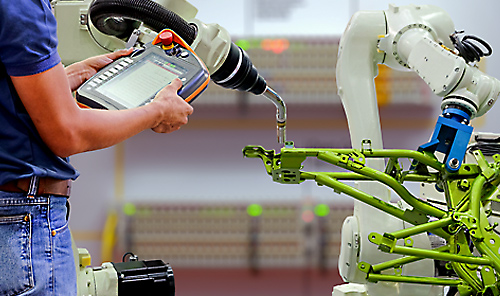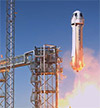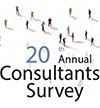Workforce Automation: Scary Threat or Major Opportunity?
Despite dire predictions that robots and automation will displace workers, studies predict automation and robotics will actually create more — but different — jobs than they displace.
Workforce Q4 2018

“Those seem to be the headlines,” acknowledges Bob Doyle, vice president of the Robotic Industries Association. Some real-world examples are from articles in respected publications: “Robots in the Workplace? Each 1 Costs 6 Jobs, New Study Finds”…“How to Survive the Robot-Fueled Jobs Apocalypse”…“Evidence That Robots Are Winning the Race for American Jobs.” Those ominous headlines, though, don’t line up with the actual findings of a number of studies, Doyle responds. “If you dig into the reports, they say automation and robotics will create more jobs than they displace,” he says.
On the Bright Side
One such study comes from the Association for Advancing Innovation, a Michigan-based umbrella group that includes the association Doyle represents. The “Work in the Automation Age” report disputes the notion that automation costs jobs and spotlights the many bright sides. “As employers add automation technologies such as robots, job titles and tasks are changing, but the number of jobs continues to rise,” the report states.
Indeed, more robots were shipped to U.S. customers in the first seven years of the current decade than in any seven-year period before, yet manufacturing employment was up by nearly 900,000. “As robot sales have gone up, unemployment has gone down,” Doyle observes. To cite some specific examples from the report, General Motors kept adding humans to its payroll even as it was adding more and more robots to its assembly lines. And Amazon is building up its robotic operations while also creating thousands upon thousands of new human jobs.
The World Economic Forum, meanwhile, predicts that 75 million human jobs will be displaced by machines and algorithms between now and 2022. That sounds bad, but the same report forecasts that these automation technologies will create 133 million jobs, for a net gain of 58 million new jobs.
A similar prediction can be found in a United Kingdom economic outlook produced in July by PwC. “AI and related technologies should create as many jobs as they displace,” the PwC report states. “AI and related technologies such as robotics, drones, and driverless vehicles could displace many jobs formerly done by humans but will also create many additional jobs as productivity and real incomes rise and new and better products are developed.”
Bhushan Sethi, strategy leader of PwC’s Workforce of the Future business, says his firm’s research predicts more than $15 trillion in GDP growth that can be linked to automation, “some by 2020, the majority between 2025 and 2030.” Yes, there will be automation, and many jobs will be impacted even as many jobs are created. But automation-driven productivity gains and business growth enabled by artificial intelligence will generate added wealth, which will result in new spending, and increased spending will drive even more job growth.
Changes brought by automation are just as profound in the office as they are on the assembly line and in the distribution center. Manpower Group weighs in with its “Skills Revolution 2.0”report. Digitization is the name of the game, and it’s happening everywhere, according to the report. Importantly, in three-quarters of the countries Manpower surveyed, companies are more likely to see automation growing their workforces rather than shrinking them. “As companies go digital,” the report says, “most will need more people, not fewer. Automation is good news for job-seekers, if they have the skills.”
The key thought, as succinctly summed up in the Manpower report, is that “robots take tasks, not jobs.” In fact, adds Doyle, robots take the tasks that a lot of people are better off not having to do, anyway. “In most cases, robots are taking tasks that are dull, dirty or dangerous, the three Ds,” Doyle says.
Disrupting the Status Quo
Of course, positive as it sounds to shield humans from the “three Ds,” doing so definitely is a disruption to the status quo. Those people whose daily work is steeped in dull, dirty or dangerous tasks may be able to avoid economic calamity as the future unfolds, but change is unavoidable.
“It’ll require retraining,” Doyle says, but companies are often eager to develop the people they know. “Companies want to invest in their people. They’re typically good employees that they want to keep.”
The truth of the matter is, even the status quo is likely to require more and more focus on training. After all, “ask any of our member companies — their biggest challenge is finding qualified people to take the jobs they have open,” Doyle says. Employers need new training options now, and “the future of increased automation will dictate workforce development that’s focused on preparing people for the world of advanced manufacturing.”
Klaus Schwab, founder and executive chairman of the World Economic Forum, had much the same to recommend in releasing his organization’s report in September. “It is critical that business take an active role in supporting their existing workforces through reskilling and upskilling, that individuals take a proactive approach to their own lifelong learning, and that governments create an enabling environment to facilitate this workforce transformation. This is the key challenge of our time.”
It’s vital that the business community, and society as a whole, figure out how to fill the skills gap, according to Doyle. He cites research from Deloitte and the Manufacturing Institute suggesting that by 2025, a couple of million jobs will be unfilled because there just aren’t enough people with the right skills. Innovative training models are the way of the future, including parallel work-study tracks and various forms of on-the-job training.
What Does the Future Hold?
The future holds a big increase in demand for such things as data analysts and scientists, application developers, and experts in e-commerce and social media, according to the World Economic Forum. There will still be plenty of demand for roles that are big on people skills, too, including customer-service professionals and marketing professionals.
The want ads will include all kinds of job titles that are unfamiliar to a lot of people today, Doyle adds. Future opportunities could include such roles as predictive equipment analytic specialist, machine algorithm designer, mechatronics technician, robotic application developer, and computer vision designer. “A lot of these are jobs that would not have existed 10 years ago,” he says.
As employers add automation technologies such as robots, job titles and tasks are changing, but the number of jobs continues to rise. “Work in the Automation Age” report, Association for Advancing Innovation There will absolutely be new jobs created,” Sethi agrees. Just a few examples: “There will be people needed to create algorithms, there will be new roles around auditing, roles making sure the algorithms are ethical.”
The future will require big-picture understanding of where in a process bots will fit best, and where they won’t, Sethi says. That is a new kind of expertise. “To really understand how work gets done, we need to go into the employee master file. What employees do I have, within what tasks and processes, and what bots do I have? The future of understanding how work gets done has to understand employees, contingent workers, and bots.”
It’s worth pointing out that the changes brought by automation are just as profound in the office as they are on the assembly line and in the distribution center. White-collar workers are affected just as much as those whose collars are blue. A lot of what Sethi tracks is the field known as robotic process automation, which involves creating software bots that learn to handle repetitive tasks performed on computer desktops. Robotic process automation can have a significant impact in the worlds of data entry, accounting, and payroll, for example.
“Many firms implement automation to say, ‘How do we take repetitive tasks and automate them?’” he says. “It’s not the job that gets automated, it’s the underlying task.”
Meanwhile, there’s lot of work to be had in areas that design and oversee the bot workforce. For example, “We still need audit and control and security. We need to make sure the underlying algorithms cannot be manipulated.”
And in any case, Sethi says, not all tasks that have the potential for automation will be automated. “Just because you can put a chatbot in a call center, that doesn’t mean every firm is going to implement a chatbot,” he says. There are legal and regulatory considerations that sometimes come into play, as well as a firm’s community connections and views on social responsibility. “It’s not just one size fits all. Do we really want to do this and what are the impacts on the community? What will happen to community relations and brand reputation if we disrupt 5,000 people?” he asks.
An Historical Perspective
If you look back in time, Doyle says, technological advances have always changed the nature of jobs. And there were always people — respected experts — who feared the impact those changes would have on those in the workforce.
Here’s a thought expressed in 1930 by the famed economist John Maynard Keynes: “We are being afflicted with a new disease of which some readers may not have heard the name, but of which they will hear a great deal in the years to come — namely, technological unemployment.” And here is what another highly regarded economist, Wassily Leontief, said in 1952: “Labor will become less and less important....More and more workers will be replaced by machines. I do not see that new industries can employ everybody who wants a job.” Those alarming warnings happened well in the past, and yet here we are today, still dealing with the workforce issues that go hand-in-hand with low unemployment.
The bottom line, says Doyle, is that “robots are tools used by more and more industries to compete in the global marketplace.” The biggest threat to jobs, it turns out, isn’t robots, but rather the inability to effectively compete. Those horror stories about robots coming to take all of our jobs? “That’s not going to happen,” concludes Doyle.
Project Announcements
Shapeways Holdings Expands Livonia, Michigan, Operations Complex
07/07/2023
Germany-Based Becker Robotic Equipment Plans Canton, Georgia, Manufacturing Complex
12/07/2022
LEGO Group Plans Chesterfield County, Virginia, Manufacturing Plant
06/17/2022
Scotland-Based PowerPhotonic Plans Sahuarita, Arizona, U.S. Headquarters-Production Campus
04/04/2022
A. Duie Pyle Plans Manassas-Richmond-Roanoke, Virginia, Cross Dock Service Centers
03/15/2022
Black Buffalo 3D Corporation Relocates-Plans Smithfield Township, Pennsylvania, Manufacturing Complex
02/07/2022
Most Read
-
The Workforce Bottleneck in America’s Manufacturing Revival
Q4 2025
-
Rethinking Local Governments Through Consolidation and Choice
Q3 2025
-
First Person: Filter King’s Expansion Playbook
Q3 2025
-
Lead with Facts, Land the Deal
Q3 2025
-
How Canada Stays Competitive
Q3 2025
-
Investors Seek Shelter in Food-Focused Real Estate
Q3 2025
-
America’s Aerospace Reboot
Q3 2025



